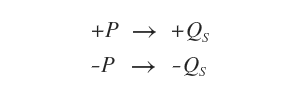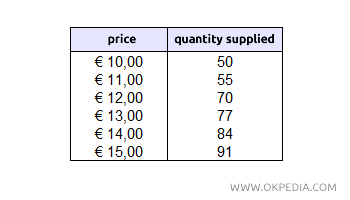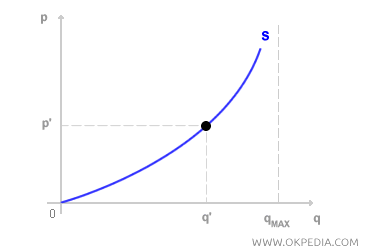Supply
Supply refers to the amount of a good or service that producers are willing to sell in the market at a given price.
Supply is a fundamental concept in economics, studied both in microeconomics (theory of supply) and macroeconomics (aggregate supply).
Law of Supply
This economic principle states that, all else being equal, the quantity of a good supplied increases as its selling price rises.

The higher the price (P) of a good, the greater the quantity supplied (QS). The reverse is also true.
Supply is directly proportional to price.
This relationship allows economists to measure the quantity of goods supplied at various price levels using empirical data.
These data are used to create a table known as the supply schedule.

Graphical Representation of Supply
The supply schedule can be visually represented using a Cartesian diagram.
Price (P) is plotted on the vertical axis, while the quantity supplied (Q) is shown on the horizontal axis.

This graphical representation is known as the supply curve.
The Theory of Supply
The theory of supply is a microeconomic framework that explains the relationship between changes in supply and changes in price using a mathematical function.
The supply function is expressed as follows:

In English-language texts, the supply function is often denoted by the variable S (supply) rather than Y.
The quantity produced (Y) of a good increases as its market price (p) rises, indicating a direct and positive relationship.
In the supply function, production (Y) is the dependent variable, while price (p) serves as the independent variable.
 Price is not truly an independent variable. In a market economy, price is determined by the interaction between supply (Y) and demand (D). Therefore, it cannot be considered an independent variable in the supply function. Only in a planned economy, where price is set by a central authority, can it be treated as a true independent variable.
Price is not truly an independent variable. In a market economy, price is determined by the interaction between supply (Y) and demand (D). Therefore, it cannot be considered an independent variable in the supply function. Only in a planned economy, where price is set by a central authority, can it be treated as a true independent variable.
Types of Economic Supply
In economics, the term "supply" can refer to the following concepts:
- Individual supply. Individual supply describes the relationship between the quantity of a good supplied by a single firm and its price. This concept belongs to microeconomics.
- Market supply. Market supply represents the total quantity of a good supplied by all firms operating in the market. It is analyzed within the framework of the theory of the firm in microeconomics.
- Aggregate supply. Aggregate supply refers to the total quantity of all goods supplied by all firms within an economy. It is a critical concept in macroeconomics and economic policy analysis.
Supply is typically associated with production or distribution firms. However, in certain contexts, it may also involve households.
The classification of supply by economic agents includes the following:
- Firm supply. The supply function for firms is driven by profit maximization while accounting for market conditions and the characteristics of the production function, which describes how inputs (factors, semi-finished goods) are transformed into outputs (finished products).
- Household supply. The supply function for households is based on maximizing net utility, subject to market conditions, resource availability, and personal preferences.
Example. Labor supply is a common example of household supply. This category also includes services provided directly to individuals, in addition to labor market activities.
Supply can also be categorized by time horizon:
- Short-term supply. Short-term supply is modeled using a production function in which only variable costs (e.g., production factors, raw materials, labor, inputs) can change. Fixed costs (e.g., capital, production capacity, technology) are treated as constant.
- Long-term supply. Long-term supply considers both variable and fixed costs as adjustable. It is illustrated with a long-term supply curve.
Example. Over the long term, firms can invest to expand production capacity, increase storage, open or close facilities, or adopt new technologies and machinery.
